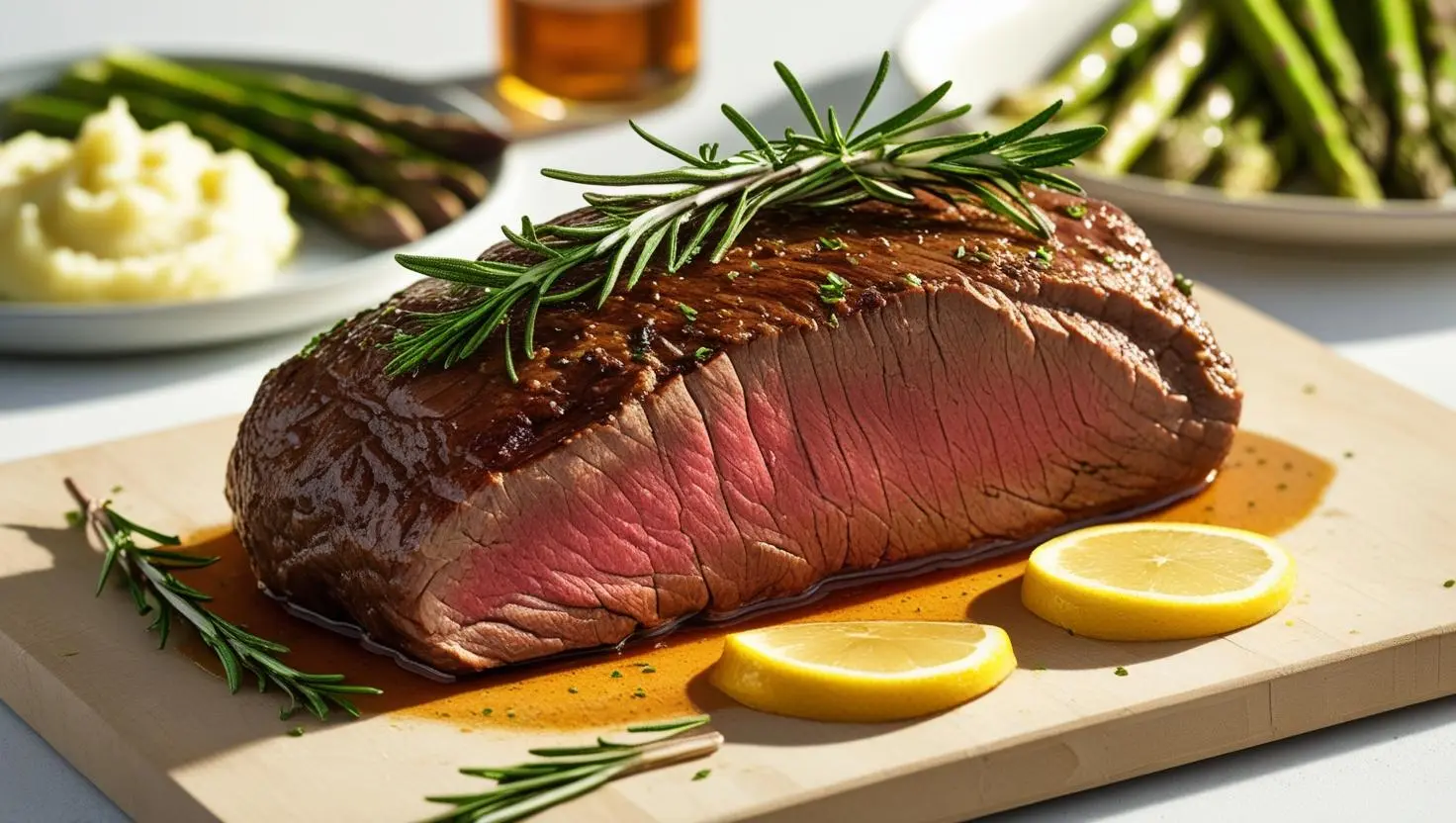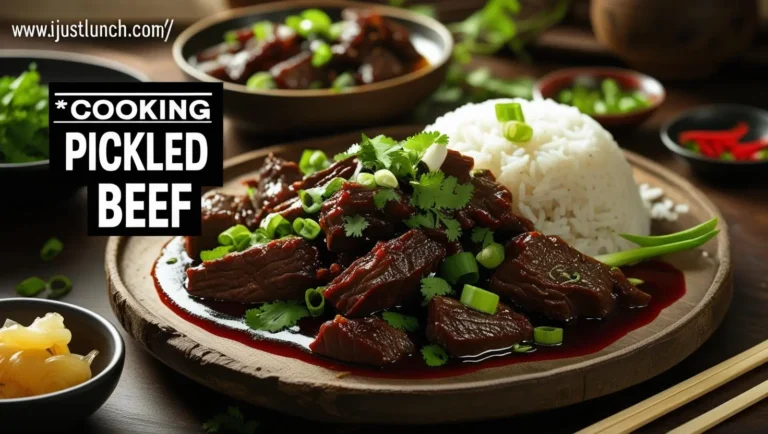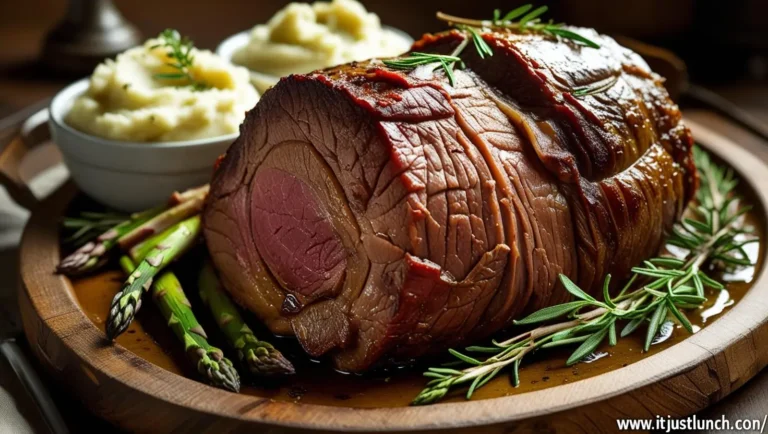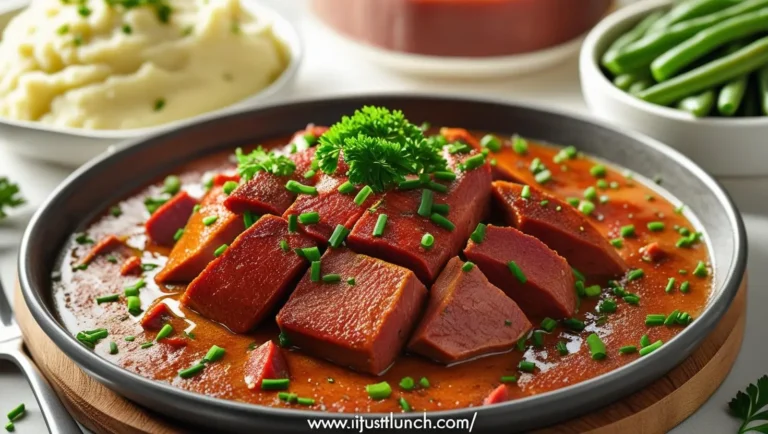sous vide beef tenderloin | Sous vide whole beef tenderloin
A Moment You Can Master
Picture this: you finally volunteer for the big family dinner, and everyone whispers about that one unforgettable meal no one can shut up about. The butcher smiles when you say whole beef tenderloin—he knows it’s the showstopper most people only dream of pulling off. Still, a tiny voice in your head keeps asking what happens if you misjudge the time and that glorious slab turns into shoe leather.
Sous vide beef tenderloin turns that anxious voice into background noise. The water around the meat stays exactly where you set it, minute after minute, degree after degree. There’ll be no eyeballing the roast, no frantic last-minute rescue, just calm, repeatable perfection that tastes as rich as the process is simple.
Table of Contents
What Is Sous Vide and Why It Works for Beef Tenderloin
Sous vide beef tenderloin (French for “under vacuum”) is as low-tech as it sounds—seal food in a bag, slip it into temperature-steady water, then walk away and live your life. Even with a cut as temperamental as tenderloin, supper never crashes because the heat never climbs past the number you chose.
Why It’s Ideal for Whole Beef Tenderloin
- Precision Cooking: The water bath eliminates those tell-tale gray rings, perimeter to center.
- Tender Results: Gentle, low heat gives the stubborn connective tissue time to relax.
- Stress-Free Process: You can talk to your guests instead of staring at the oven timer.
Sous Vide vs. Oven Roasting
| Feature | Sous Vide | Oven Roasting |
|---|---|---|
| Temperature Control | Set it to 129°F, and it stays | Thermostat drifts, so who knows? |
| Consistency | Edge to edge the same, every bite | Dry patches show up when you least expect them |
| Timing Flexibility | Keeps the meat warm for hours | Miss the window and dinner’s ruined |
Choosing the Right Whole Beef Tenderloin
What to Look for When Shopping
- Grade: A spinal-tap moment; Prime or Choice is worth the small bump in cost.
- Weight: Three to five pounds keeps four to eight diners happily engaged.
- Trimmed or Untrimmed: Peeled or PSMO lets the butcher do the heavy lifting, or you can if you want the workout.
Best Places to Buy
- A local butcher will chat and hand-cut while you wait—no extra charge for personality.
- Warehouse clubs bundle savings with cartloads of beef.
- Online purveyors ship overnight, so the happy cow arrives almost as fresh as the one at the farmers market.
Ingredients and Tools Checklist
Ingredients Table
| Ingredient | Amount | Notes |
|---|---|---|
| Whole beef tenderloin | 3 to 5 pounds | Peeled is easier but whole works too |
| Kosher salt | 1 to 2 tablespoons | Enough to build a crust beneath the skin |
| Black pepper | 1 tablespoon | Grind it yourself; store-bought won’t sing |
| Garlic cloves | 3 to 5 | Give them a smash—bad guys do not hide |
| Fresh rosemary | 2 or 3 sprigs | Toss if you want the kitchen to smell alive |
| Butter | 2 tablespoons | The last minute fairy dust, trust it |
| Olive oil | 2 tablespoons | Liquid gold for that first blistering contact |
Tools You’ll Need
- Reliable sous vide circulator
- Anything sturdy enough to hold a beefy water bath
- Vacuum sealer or the rugged zip-top-and-dunk trick
- Heavy cast-iron skillet for a proper sear
- Simple tongs, paper towels, and a probe thermometer never hurt either
Step-by-Step Guide: Cooking Sous Vide Beef Tenderloin
Step 1: Trim and Season
- Strip off the silver skin and floppy fat; leave the lean stuff alone, please.
- Coat every inch with kosher salt and walk away for 1 or 2 hours; the fridge is fine uncovered.
Step 2: Seal and Prep Water Bath
- Toss in cracked pepper, busted garlic, maybe rosemary if the mood grabs you.
- Lock the whole package—tight with a vacuum sealer, or squeeze air out of a freezer bag the H₂O way.
- Dial your circulator to the temp that matches your idea of perfect sous vide beef tenderloin.
Step 3: Cook Sous Vide
| Doneness | Target Temp | Cooking Time |
|---|---|---|
| Rare | 122°F | 2.5 to 4 hours |
| Medium-Rare | 129°F | 3 to 4 hours |
| Medium | 135°F | 3 to 4 hours |
Tip: Stop at four hours if you want to keep that steak bite chewy rather than mushy.
Searing for a Restaurant Finish
- First, lift the sous vide beef tenderloin from its bath and blot it dry with paper towels.
- Set a cast-iron skillet on the highest burner until it begins to smoke.
- Swirl in a dash of oil then lay the steak in; 45 to 60 seconds brings a crust.
- If you like, toss in a pat of butter and some herbs for a quick baste before pulling it off the heat.
Slicing, Saucing, Serving
- Let the sous vide beef tenderloin sit for five minutes so the juices settle.
- Cut across the grain into half-inch medallions that fan out nicely on a platter.
- For flair, sprinkle fresh herbs or drizzle one of the following sauces.
Favorite Sauces
- Garlic-herb butter melts elegantly on warm meat.
- A spoonful of creamy horseradish adds a spicy kick.
- Pan juices reduced with a splash of red wine taste like the kitchen spent hours.


Beverage Suggestions
- Rich reds such as Cabernet Sauvignon or Syrah share the plate well.
- For something lighter, sparkling water with lemon wakes up the palate.
Storage and Reheating
- Tuck leftover sous vide beef tenderloin slices in an airtight dish and slide them into the fridge; they keep four days.
- Seal portions in vacuum bags and freeze for three months without freezer burn.
Reheating Without Drying Out
- Fire up the immersion circulator to 120°F (49°C) and slip the sealed package of sous vide beef tenderloin into the water for half an hour or so.
- If you want a flash of char afterward, give the meat a quick second sear.
Frequently Asked Questions
Is sous vide beef tenderloin really better than oven-roasting?
Every slice, from rim to core, hits the same ideal shade of pink. That kind of insurance is something a broiler simply won’t offer.
Can I cook sous vide beef tenderloin straight from frozen?
Go right ahead—just tag on an extra hour and forget about thawing.
Do I have to sear sous vide beef tenderloin afterward?
Absolutely. The sous-vide process nails the center, but the blistering crust that seals in flavor comes only from a hot skillet, torch, or grill.
What if I don’t have a vacuum sealer for sous vide beef tenderloin?
A sturdy freezer bag works perfectly. Lower it into the water pouch-first to crease the plastic around the meat, and most of the air will be pushed out. Zip the seal once the bag’s neck is submerged.
Final Thoughts: Bring the Steakhouse Home
You don’t need Michelin stripes to plate a sous vide beef tenderloin that sings. Follow these steps and treat yourself to steakhouse luxury right in your own kitchen.
You’ve got the full playbook in your hands now. The perfect cut, the seasoning dance, the final garnish—looking good on the plate—it all lines up step by step. Yes, it’s intimidating, but go ahead and dive in. The moment you strike that first slice of sous vide beef tenderloin, you’ll know there’s no safe shore left, just the thrill of the cook.
Have you fired up the technique yet, or is something still nagging at you? Swing by the comments and let the kitchen crowd hear your win or your worry. If the rhythm of weekly recipes perks up your cooking pulse, hit subscribe and watch your inbox become a fresh-baked newsletter.





